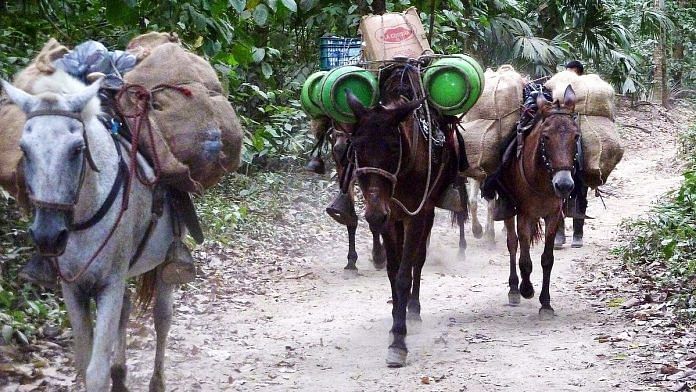Bengaluru: Genetic analysis of modern and ancient donkeys carried out by an international team of scientists has revealed that, unlike other animals that are a part of human society, donkeys were domesticated only once in history. The findings on the domestic donkey, Equus asinus, were published in the journal Science last week.
The study found that domestication occurred around 5,000 BCE in East Africa, after which donkeys rapidly spread through Eurasia, becoming distinct subpopulations that remained genetically isolated, possibly because the Sahara then turned from forest to desert.
This rapid spread and genetic isolation helped in pushing the donkeys into their critical role as the ‘beast of burden’ in our societies, helping humans to transport goods across a range of landscapes and environments and thrive, the researchers found.
Until now, not much had been known about the evolution of donkeys, as the species has slowly been phased out of industrialised human societies. The findings follow those about other animals — such as horses and dogs, bats, and bacteria — whose evolutionary history is newly privy to human eyes because of our increasingly complex genomic sequencing abilities.
The authors of the study sequenced the genomes of 207 modern donkeys from Central Asia, Africa, the Arabian Peninsula, and Europe; 31 ancient donkeys from fossils spread across Central Asia and Europe, and 15 wild animals of the horse family. The sequencing data indicated that modern donkeys descended from ancient ones that people had selected and often inbred or interbred for large size and strength.
The researchers also documented a previously unknown genetic lineage in the Levant region around 200 BCE that contributed to the genetic flow of donkeys from Africa to Asia. Genetic sequences then flowed back from Europe, Asia, and the Levant to the donkey populations in western Africa.
Donkeys, asses (wild donkeys), and mules (donkeys crossed with horses) have contributed significantly to the development of civilisation in various pockets of the world. They continue to be in use for labour today, especially in low and middle-income countries, and those with difficult terrain.
Also Read: Thousands of animals are being relocated in Zimbabwe due to climate change
Donkeys used in fighting climate crisis
The important role played by donkeys — a part of many of our pop cultures up until a few years ago — has been visibly noted in archeological and fossil finds.
For example, nine of the ancient donkey genomes used in the study came from an archaeological site in France, which housed a Roman villa in the years 200-500 CE. The villa appeared to have had a donkey breeding centre. Genetic data suggest that Romans interbred African and European donkeys into “giant” donkeys that were 25 cm taller than a typical member of the species, which averages about 130 cm.
Donkeys are also often thought of as a source of help during the crises resulting from climate change, as they are used to deliver aid to disaster-hit areas in low and middle-income countries.
Many believe that as draught (working) animals that carry heavy loads, donkeys are resilient in the face of extreme weather conditions and can contribute to sustainability by participating in agricultural production and economical management in rural communities, especially those that do not have access to industrial equipment.
“Efforts to characterise modern donkey diversity around the world should continue,” the researchers said in the report. “Such efforts may not only refine the historical legacy of past populations into the modern world but also uncover the genetic basis of desert adaptations, which could prove invaluable for future donkey breeding in the face of global warming.”
(Edited by Siddarth Muralidharan)
Also Read: Diversity among reptiles a result of global warming 250 years ago, finds study



